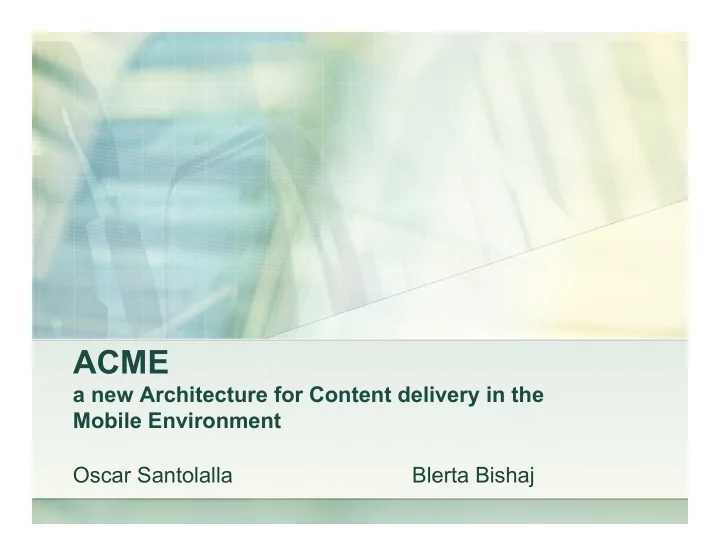

ACME a new Architecture for Content delivery in the Mobile Environment Oscar Santolalla Blerta Bishaj
Agenda • Introduction • ACME • ACME in CDMA Networks • ACME Director • Conclusions
Introduction • Increasing use of web access from mobile devices in 2.5G and 3G mobile networks • Mobile networks are characterized by an error-prone air interface , link-layer retransmissions, latency
Introduction Content Delivery in wireline internet (1) • Network scaling It achieves: - reduced load at the origin server - web caches - distributed origin server - Content Delivery Networks (CDNs) - reduced latency
Introduction Content Delivery in wireline internet (2) • End-system acceleration - server farms and balance loader • Content and protocol optimization - eliminate redundancy - content adaptation, like compression - protocol optimization, like TCP connections in HTTP
Introduction Content Delivery in wireless internet Problem: the air interface is a bottleneck Solution: the split-proxy architecture - shields internet apps from wireless network specifics - already used by WAP - ACME is a flavour of this architecture
Agenda • Introduction • ACME • ACME in CDMA Networks • ACME Director • Conclusions
ACME Architecture for Content delivery in the Mobile Environment • exploits user interest correlation – push content other users request • assumes unlimited-capacity cache • trades local storage for latency reduction and bandwidth efficiency • each requested web object is broadcast to every terminal
ACME How it improves the performance • increased hit ratio improves user experience Baseline ACME E[T B ] = 2 + e G -1 exp(G M ) -1 E[T B ] = ( 2 + ) * (1 - h) q r q r 1 – at least 2 timeslots 1 – some requests are served immediately 2 – faster medium access due to reduced medium contention h – hit ratio 3 – the higher the h, the better the N – terminals performance λ – Poisson rate of requests G – total load of the bandwidth q r – retransmission probability
Agenda • Introduction • ACME • ACME in CDMA Networks • ACME Director • Conclusions
ACME in CDMA networks Near-far problem : Signals • B for farther terminals are overwhelmed by other A nearby signals. Solution : Terminal power • control Base C station Major benefit is reduced interference. Assuming A is an ACME-enabled terminal: – Signals sent to B and C will reach A with very low Signal-to-interference ratio (SIR) so its content can be decoded with low error rates – Consequently the content is cached by A – A will improve its hit ratio and reduces bandwidth usage
Agenda • Introduction • ACME • ACME in CDMA Networks • ACME Director • Conclusions
ACME Director ACME Director is a server that uses interest correlation information to • perform selective multicast for every content request. Director’s Objective: To achieve high hit ratio with a small multicast group •
ACME Director How does ACME Director work? On-demand broadcast is too power-consuming for mobile devices. ACME • rather uses selective multicast. Edge caching lies on the fact that different users have overlapping interest • in content. The algorithm the ACME director uses • Matrix of P( j | i ) , where p(j|i) is the probability that user j will access a web • object previously accessed by user i. multicast factor ( α ) •
ACME Director Director Effectiveness (1) Objective of simulations : evaluate caching performance and terminal power consumption relation Director Parameters: Multicast factor α : • α =0 is unicast (client caching) • α =1 is broadcast (full edge caching), every terminal receives a copy of the • requested content Director effectiveness E( α ), measures ACME Director’s performance and is • dependent on both α and hit ratios. Relative push group size s( α ), normalized number of terminals receiving a • pushed object for a defined α . It is proportional to average terminal power consumption .
ACME Director Director Effectiveness (2) Effectiveness (caching performance) Results: s( α ) = 0.7 – 6 % • => Efectiveness = 50% s( α ) near to 20 % • => Efectiveness = 80% Relative push group size s( α ) • does not increase proportionally to the general Relative push group size user group size, because it keeps only the users with the ( terminal power consumption) closest interest. * UCB, BU, NLANR are web traces collected of users with wireline proxy connections
ACME Director Refinements to Director ACME also improves radio resource management . In case of increased • network utilization, the multicast can be spread more, to reduce the terminals’ need to use the network bandwidth in the future Examples: • Director pushes more content if the phone is • connected to AC power Director stops pushing if terminal has fallen • certain threshold Conclusion : It balances bandwidth-delay-battery
Agenda • Introduction • ACME • ACME in CDMA Networks • ACME Director • Conclusions
Contemplating ... In the web, we often follow link paths – false interest correlation • Table Maintenance • huge tables to maintain according to ACME, little gain from increasing the group size Is user-to-user interest correlation a good guess? • ACME not clear about how to buid the table Maybe user-to-interest correlation? User-to-user is misleading and inaccurate Web browsing not yet very successful with the mobile hosts • Maybe notification nature in the future? Who pays for the pages ACME multicasts? •
Possible solution? • Wise cell projection, to discover profiles stadiums theatres universities • Maybe, notify the users about events according to their profiles
Conclusions About the content delivery scenario: Air interface is the bottleneck of mobile web user experience • It is difficult to characterize and quantify correlation interest • because of many factors About ACME itself: It adds a new dimension in radio resource management • We think ACME makes false or too-good assumptions • Not likely to be deployed any soon •
Questions?
Recommend
More recommend